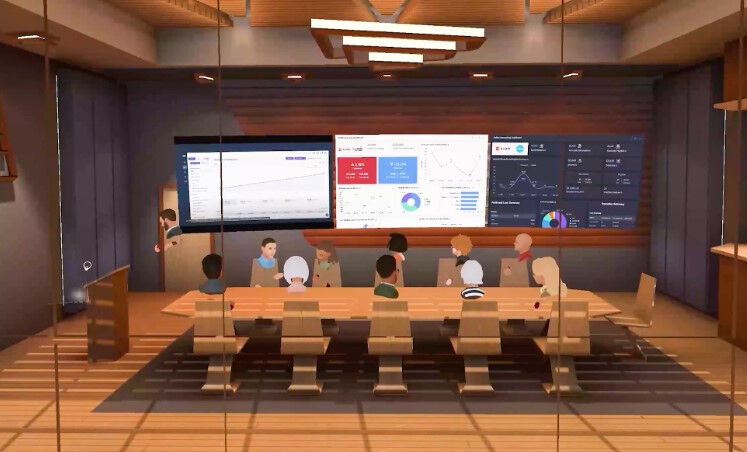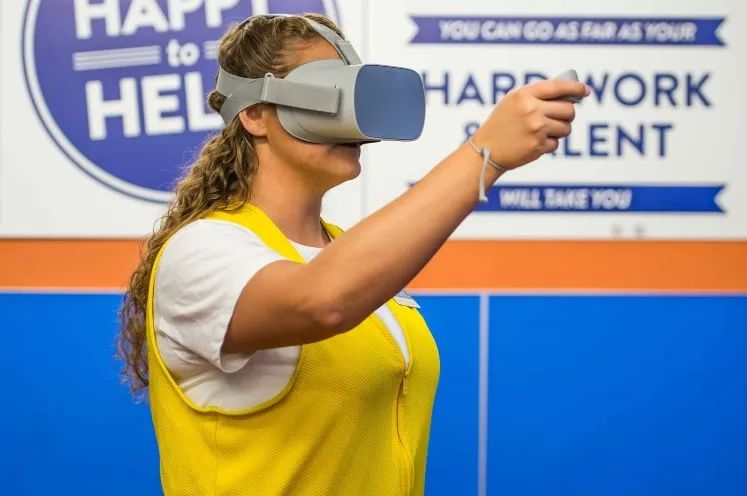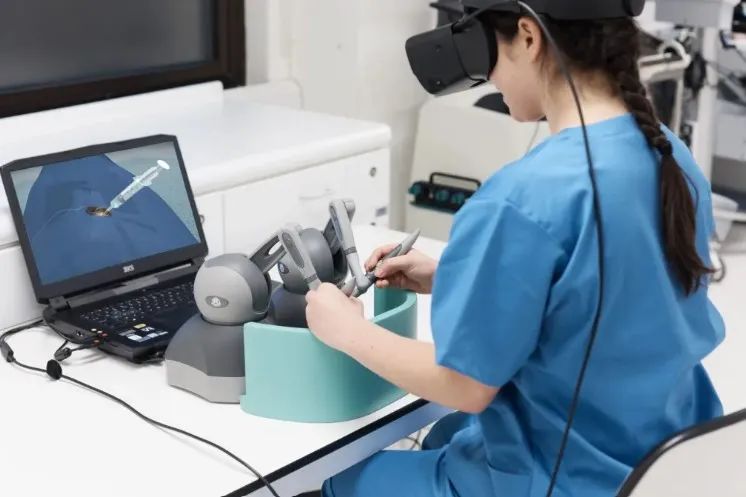"VR/AR in 2024: Key Trends and Challenges Ahead"
09

08
2024
"In the ever-evolving technological landscape, Augmented Reality (AR) and Virtual Reality (VR) have not only become buzzwords but also key forces shaping the future of business. For forward-thinking business leaders, the need to harness the potential of AR/VR technology is more critical than ever. This article explores several key trends and challenges in the AR/VR landscape for 2024, offering strategic insights for executives aiming to navigate and leverage the virtual frontier."
Key Takeaways
· Growth of AR/VR Wearable Devices: VR/AR wearable devices will experience massive growth in 2024, providing immersive experiences for both individuals and businesses.
· The Year of Mixed Reality (MR): AR and VR are converging to create mixed experiences. Companies like BMW are using MR for driving assistance.
· Opportunities for App Developers: The increasing demand for VR/AR applications opens up new avenues for mobile app development across various sectors.
· Meeting Generative AI: AI can significantly accelerate and simplify VR/AR content creation, benefiting marketing, advertising, and design.
· From Physical to Boundless Workspaces: VR/AR enables institutions to achieve virtual collaboration and remote training.
· VR/AR Revolutionizing Healthcare: Key areas of healthcare applications include immersive training, improved accessibility, and mental health support.
· Lack of Awareness and Experience: Companies need continuous learning, research, and collaboration to overcome this challenge.
· Integration with Existing Systems: It is crucial to examine existing systems, invest in infrastructure, and foster internal collaboration.
· Diversity and Inclusion: Companies should ensure accessibility for users with disabilities and tap into this niche market.
· Data Security and Privacy: Robust security measures, user education, and transparent data policies are essential to address these issues.
VR/AR Technology in 2024: 6 Significant Trends
Growth of AR/VR Wearable Devices
Motion tracking devices and smartwatches once represented the pinnacle of wearable technology, but now they are just the tip of the iceberg. With the emergence of AR/VR and the highly anticipated launch of Apple’s Vision Pro, wearable devices have been elevated to a whole new level. Currently, there is a surge in devices developed by major tech companies such as ASUS AirVision M1, Valve Index, and Meta Quest Pro, highlighting the increasing popularity of wearable devices by 2024. It is predicted that more ergonomic and affordable wearable technology models will soon emerge. This revolution provides users with immersive and personalized experiences, but its impact extends far beyond localized spaces. In organizational environments, particularly in manufacturing, AR projections offered by wearable devices can display step-by-step production processes in high-quality simulated forms, from assembly and inspection to maintenance. This facilitates effective cross-department communication and reduces optimization time. The surge in these devices provides unprecedented opportunities for businesses across various industries to explore their own new use cases and drive organizational performance.
The Year of Mixed Reality (MR)
The convergence of AR and VR, commonly referred to as Mixed Reality (MR), is expected to make significant strides in 2024. As traditional virtual reality headsets evolve into devices with mixed reality capabilities—such as Meta Quest 3 and Apple’s Vision Pro—a new era of mixed experiences has officially arrived. Additionally, integrating multisensory technology can enhance the mixed reality experience, fostering more authentic and memorable interactions. In entertainment and experimental fields, this potential combination can provide dynamic interactions between subjects and environments, enabling comprehensive data collection. BMW is actively pursuing technological advancements and is at the forefront of innovation among global automakers. At the 2022 Lisbon Network Summit, BMW introduced the concept of a mixed reality driving experience, where driving can take place in both the physical and virtual worlds. Recently, at CES 2024, this German automaker showcased its use of the XReal Air 2 AR glasses, which can display navigation directions, hazard warnings, and infotainment data within the driver’s line of sight, regardless of where they look.


Opportunities for App Developers
The increasing adoption of AR/VR by individuals and businesses, along with the proliferation of wearable devices, signifies a new demand for applications specifically tailored to this technology. This opens up new revenue streams for mobile app development companies. The adopters of this technology are no longer limited to entertainment and gaming; they are seeking applications that span from health to productivity. Once unmet needs are identified in the market, the scalability for app developers is limitless.


One Thing App Developers Need to Remember
One thing app developers need to remember is that cross-platform compatibility should be a top priority to ensure seamless integration between devices and wider adoption. To achieve this, regular testing and debugging should be conducted to ensure that applications run smoothly across different devices.
Creating VR/AR content can be time-consuming, but that is changing with the emergence of generative AI. Generative AI can produce designs at a speed faster than manual processes, saving significant costs, streamlining the development of VR/AR content, and helping businesses introduce experiences to users sooner. In the marketing realm, MR advertising can greatly benefit from generative AI as a partner: businesses no longer need to spend extensive resources on graphic design and video production; instead, they can leverage the capabilities of generative AI to create highly customized and adaptive ad content, allowing them to focus on the strategic aspects of the overall campaign. If necessary, the generated content can be further refined to create the perfect ads that resonate with brand identity and target audiences. Advertisers can also choose from different ad variations to experiment and flexibly tailor campaigns for various audience segments, thanks to the extraordinary speed and efficiency of generative AI in producing designs. With these two technologies complementing each other, advertisers have endless opportunities to effectively engage their audiences. By 2024, time-consuming design processes will be a thing of the past.
From Physical Stores to Boundless Workspaces
With the emergence of AR/VR, the dynamic landscape of the office is on the brink of transformation. From redefining traditional workplaces to revolutionary training programs, these innovations will reshape how employees perceive and engage with corporate environments. When it comes to workspaces, VR/AR introduces the concept of virtual collaboration, liberating teams from geographical constraints and fostering a global workforce. Imagine employees from around the world participating in a virtual meeting without needing to travel to a physical office. 3D avatars will replace physical presence, and dynamic 3D presentations will take the place of static slides, making remote collaboration feel more natural than ever before. As hybrid and remote work become increasingly common by 2024, the “boundless” workspaces enabled by VR/AR can provide significant operational efficiencies for businesses. At the same time, training models are undergoing a major transformation as VR/AR creates immersive learning environments and interactive simulations. Remote training and onboarding have become a reality, offering companies a cost-effective and globally applicable approach to employee development. According to a Deloitte survey of over 350 executives in the U.S. manufacturing sector in 2023, immersive training ranks third among the most common use cases in the industrial metaverse. Key benefits highlighted include improved employee retention and reduced costs.


Revolutionizing Healthcare Through AR/VR
Driven by technological advancements, demographic changes, and the ever-evolving needs of patients, the global healthcare sector is undergoing an unprecedented transformation. In 2024, AR/VR will further propel this trend, fundamentally changing healthcare services worldwide. VR/AR is increasingly being utilized in medical training, providing immersive simulations to enhance the skills and confidence of healthcare professionals. For example, AR/VR anatomical visualization can guide surgeons to achieve maximum precision during operations. Furthermore, this technology is facilitating advancements in remote consultations and telemedicine, making healthcare more accessible and personalized.


VR Provides Surgical Simulation and Feedback
VR/AR will also play a crucial role in supporting mental health, a field that will receive increased attention in 2024. According to the American Psychiatric Association, a retrospective study from 2018 indicated that VR can be used to help patients manage stress and practice mindfulness through realistic visual and auditory elements. Meanwhile, a review study conducted by researchers at the University of Copenhagen in 2021 showed that virtual reality can address the challenges of transferring cognitive training to real life by providing engaging virtual experiences for patients with cognitive impairments.
Four Major Challenges of AR/VR in 2024
While the potential of AR/VR is undeniable, the road to widespread adoption is not without obstacles. As forward-thinking business leaders, it is crucial to confront these challenges in order to make informed decisions about integrating AR/VR into your operations. This is essential. Let’s delve into some key obstacles and explore suggested approaches to help you further navigate these immersive technologies and fully unleash their transformative power.
Lack of Awareness and Experience
One ongoing challenge that makes business leaders hesitant to adopt VR/AR solutions in 2024 is the lack of understanding and experience with the technology. Many companies may not fully grasp the potential capabilities of VR/AR and how to integrate it into various business processes. Due to the absence of widely recognized success stories, some businesses may even struggle to identify specific use cases for AR/VR within their industries. Most importantly, information regarding ROI (return on investment) and the costs involved—such as hardware, services, and software licenses—is often insufficient. As they enter 2024, corporate executives need to recognize the importance of continuous learning. By delving into industry reports, existing case studies, and expert insights, they can become more familiar with the technology and develop comprehensive implementation strategies. Establishing external partnerships with professional service firms and software providers can also help gain more knowledge and experience in the AR/VR field.
Integration with Existing Systems
Integrating VR/AR content into a company’s existing hardware and software platforms can be challenging:
· Some hardware limitations include expensive graphics cards, limited storage capacity, and multiple interfaces that are not optimized to work together.
· Regarding software challenges, developing immersive virtual environments requires complex programming to be executed by engineers with specialized expertise, which may not be readily available in the existing workforce. The standards for integrating VR/AR with existing systems are still evolving, making it more difficult for businesses to find a unified integration path.
While industry participants are actively developing best practices for VR/AR integration, business leaders should take the initiative to conduct a thorough audit of existing systems to better understand integration needs and adjust processes as necessary. They should also continue to invest in hardware, software, and digital infrastructure to better prepare for future integration of these technologies. During the integration planning phase, collaborating internally with stakeholders from cross-functional areas is also essential to consider diverse skills and perspectives.
Considerations for Diversity and Inclusion
As society's awareness of diversity and inclusion continues to grow in 2024, it is highly recommended that business leaders consider these factors when developing digital experiences. By ensuring that all users can access VR/AR applications, companies not only contribute to a more inclusive digital environment but also tap into significant niche markets. People with disabilities represent a large consumer group; therefore, providing accessible AR/VR experiences can help businesses reach a broader audience and gain a competitive advantage.
For companies planning to implement AR/VR solutions, how can they begin to eliminate these barriers? A research article published in 2023 outlines future pathways for improving the accessibility of immersive technologies for users with physical, visual, hearing, and cognitive disabilities by collaborating with disabled participants and other key stakeholders. These identified pathways provide a solid foundation for companies to address existing technological challenges and ethical issues, ensuring that people with disabilities are not left behind in the proliferation of AR/VR technologies.


Data Security and Privacy
As AR/VR penetrates various industries, a multitude of potential security vulnerabilities begins to emerge. AR/VR systems often require access to personal data, such as location and facial features. If not carefully protected, malicious third parties could exploit this data to track users, steal their information, and launch phishing attacks. Future cybersecurity threats are expected to become more complex than we currently imagine. Furthermore, privacy violations can lead to serious legal repercussions, damaging customer trust and business reputation. For instance, Clearview AI, a company developing facial recognition software for AR glasses, faced legal challenges in 2020 for collecting and storing a large number of facial images without consent. The company faced a $22.6 million fine in the UK and a €20 million fine from the Italian data protection authority.
To ensure the data security of end users, developers should implement robust strategies, such as secure communication protocols, strong authentication mechanisms, and, most importantly, user education. Additionally, all AR/VR applications should fully disclose in their privacy policies how user data is stored and used, as well as any external parties with whom sensitive data is shared. For business adopters, it is crucial to apply the same level of strategic effort to privacy issues as is applied to the AR/VR initiatives themselves.
Summary
As we navigate the dynamic landscape of augmented reality (AR) and virtual reality (VR) in 2024, the trends we explore reveal a shift in paradigms across sectors from entertainment and advertising to healthcare. However, amidst the potential promises, there exists a range of challenges that require strategic awareness from business leaders. Addressing the issues of lack of understanding and data security, and ensuring seamless integration with existing systems, is a top priority for business adopters. Remember, the success of VR/AR initiatives hinges not only on identifying trends but also on actively confronting the challenges that arise. Esteemed visionary readers, are you ready to venture into the realm of VR/AR and launch valuable use cases for your business? Contact us for collaborative consulting and to devise disruptive VR/AR solutions! We look forward to hearing your vision and becoming a part of your success.


